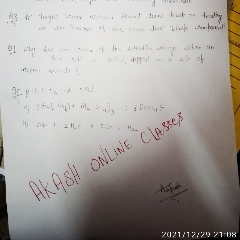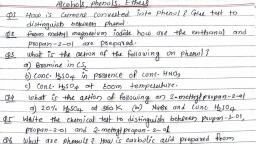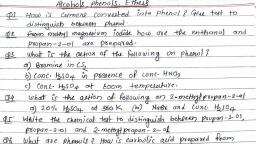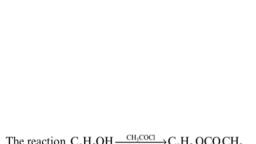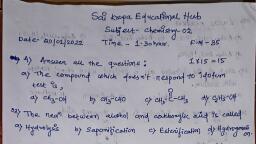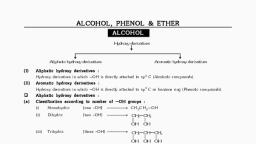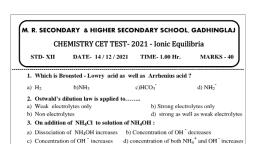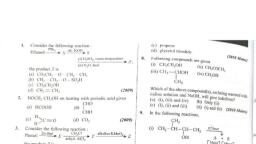Question 6 :
Compond (X) $\xrightarrow[]{(1)HgSO_4} \xrightarrow[]{(2)NaBH_4} \xrightarrow[]{(3)ZnCl_2}$ product gives precipitate in $5$ min.<br>Compound (X) is
Question 7 :
The suffixes for alcohols, aldehydes and ketones, according to IUPAC system are respectively :<br/>
Question 9 :
Ethene reacts with $Y$ to produce ethanol.<br>$ethene + Y \rightarrow ethanol$<br>What is $Y$?
Question 10 :
The process of conversion of sodium phenoxide to phenol during the preparation phenol from benzene sulphonic acid is called as _____ reaction <br/>
Question 12 :
Benzene vapour mixed with air when passed over $V_{2}O_{5}$ catalyst at $500^{\circ}C$ gives.
Question 13 :
Joseph Lister discovered 'carbolic acid' for use in antiseptic surgery in $1834$ which saved many mothers during childbirth in those days. 'Carbolic acid' was the name used for:
Question 16 :
Compound $(A)$ $C_5H_{10}O$ forms a phenylhydrazone and gives negative Tollen's and iodoform test. Compound (A) on reduction gives n-pentase. Compound $(A)$ is:
Question 17 :
$R-\overset { \overset { O }{ || }  }{ C } -OH\underrightarrow { (?) }      {R- CH_2}-OH$<br/><br/>Here reagent is :
Question 18 :
$CH_3CHO\overset{dil\cdot NaOH}{\longrightarrow}A\overset{\Delta, dehydration}{\longrightarrow} B \overset{Ni/H_2}{\longrightarrow} C \overset{Ni/H_2}{\longrightarrow} D$<br/><br/> In the above sequence of reactions, compound D is:<br/>
Question 19 :
$3$-Hydroxy butanal is formed when (X) reacts with (Y) in dilute (Z) solution. What are X, Y and Z?
Question 21 :
When $CH_3MgI$ is made to react with acetone and the addition product is hydrolysed, we get:
Question 25 :
What will be product when lithium aluminum hydride react with propanal?
Question 26 :
Which reagent can be used to complete the following reaction?<br/>$ n\ C_{3}H_{7}-CO_{2}H\xrightarrow? n\ C_{4}H_{9}OH$<br/>
Question 27 :
Reaction of which among the following ethers with $HI$ in cold leads to formation of methyl alcohol?
Question 30 :
What will happen when diethyl ether treated with hot and conc. $HI$?
Question 31 :
Ethanoic acid can be obtained from ethanol by the process of :<br/>
Question 32 :
Acetyl bromide when reacts with excess of $CH_3MgI$ followed by treatment with saturated solution of $NH_4Cl$ it gives.
Question 33 :
An organic compound (A) reacts with methyl magnesium iodide to form an addition product which on hydrolysis forms the compound (B). Compound (B) gives blue colour salt in Victor Meyer's test. The compounds (A) and (B) are respectively:
Question 34 :
Which of the following are the starting materials for the Grignard's synthesis of tert. butyl alcohol?
Question 36 :
Propane is not formed when ${C}_{3}{H}_{7}MgBr$ is treated with _________ .
Question 37 :
Acetone on treatment with $ CH_3 -Mg -I $ and on further hydrolysis gives 
Question 38 :
Primary alcohols are obtained by the reaction of Grignard reagent with : <br/>
Question 39 :
Identify the reactant $ X $ and the product $ Y $ <br/>$ CH_3 - CO - CH_3 + X \rightarrow (CH_3)_3C - OMg - Cl $<br/>                                                         $ {\downarrow}{Hydrolysis} $ <br/>                                                      $ Y + Mg (OH) Cl $<br/>
Question 41 :
Which of the following alcohol cannot be synthesized by using $\displaystyle { C }_{ 2 }{ H }_{ 5 }-Br$?
Question 44 :
Which of the following products is formed when benzaldehyde is treated with $ CH_3MgBr $ and the addition product so obtained is subjected to acid hydrolysis
Question 45 :
Which is the major product obtained by hydrolysis of compound formed by reaction between<br>formaldehyde and ethyl magnesium bromide?
Question 47 :
A primary amine can be converted to an alchohol by the action of
Question 49 :
Assertion: The solubility of n-alcohol in water decreases with an increase in molecular weight.
Reason: The reactive proportion of the hydrocarbon part in alcohols increases with increasing molecular weight which permits enhanced hydrogen bonding with water.
Question 50 :
Which of the following alcohols is the least soluble in water?
Question 51 :
Among the three isomers of the nitrophenol, the one that is least soluble in water is:
Question 53 :
Solubility of alcohols in water is _______ to that of hydrocarbons of comparable molecular masses.<br/>
Question 56 :
Which of the following statements is not correctly showing the trend of the properties mentioned ?
Question 57 :
Unlike phenol, 2,4-dinitrophenol is soluble in sodium carbonate solution in water because ?
Question 58 :
Alcohols containing only up to ___________ carbon atoms are completely miscible with water.<br/>
Question 59 :
Alcohols containing only up to ________________carbon atoms are completely miscible with water.
Question 60 :
Which of the following reactions can be used to prepare $\begin{matrix} & OH & \\ & | & \\ C{ H }_{ 3 }- & C- & { C }_{ 6 }{ H }_{ 5 } \\ & | & \\ & { C }_{ 2 }{ H }_{ 5 } & \end{matrix}$
Question 62 :
Identify by compound $B$ in the following series of reaction.<br/>Propanenitrile $\xrightarrow{Na/alc} A \xrightarrow[dil. HCl]{NaNO_2} B$.
Question 63 :
The general molecular formula, which represents the homologous series of alkanol is:
Question 64 :
Consider the following reaction sequence.<br/>$\displaystyle { CH }_{ 2 }={ CH }_{ 2 }\xrightarrow [ dil.{ KMnO }_{ 4 } ]{ cold } A\xrightarrow [ { PCl }_{ 5 } ]{ excess } B$<br/>The products $(A)$ and $(B)$ are, respectively:<br/>
Question 65 :
Choose the correct answer among the alternatives given,<br/><br/>One mole of ethyl acetate on treatment with an excess of $LiAlH_4$ in dry ether and subsequent acidification produces:
Question 67 :
The coupling between ${C}_{2}{H}_{5}MgBr$ and $MeBr$ gives propane in the presence of:
Question 68 :
Assertion: Solubility on n-alcohols in water decreases with increase in molecular weight.<br/>
Reason: The relative proportion of the hydrocarbon part in alcohols increases with increasing molecular weight which permits enhanced hydrogen bond with water.
Question 69 :
$(CH_3)_2CHCHO+CH_3MgBr \xrightarrow {ether} A \xrightarrow {H_3O^+} B$<br/>The IUPAC name of '$B$' is :
Question 70 :
Acetic anhydride on reduction with $ LiAlH_4 $ in ether gives
Question 71 :
Statement-1: In the fermentation process of molasses, along with yeast, $(NH_{4})_{2}SO_{4}$  and $(NH_{4})_{3}PO_{4}$ are added.<br/>Statement-2: Both $(NH_{4})_{3}PO_{4}$ and $(NH_{4})_{2}SO_{4}$ act as food and help in the growth of yeast.<br/>
Question 73 :
Phenol is an organic compound even though it is soluble in water due to the presence of:
Question 74 :
Which of the following compounds will giveethyl alcohol on reduction with $LiAIH_{4}$?
Question 76 :
Which of the following is not an example of symmetrical ether?
Question 77 :
Which of the following are the starting materials for the synthesis of t-butanol?<br/>
Question 78 :
$C_6H_6$ + hot conc. $H_2SO_4$ $\rightarrow$ $X$<br/>$X + Y  \rightarrow$ phenol<br/>Identify $X$ and $Y$.
Question 79 :
Which of the following will form ${ 1 }^{ o }$ alcohol?
Question 80 :
$0.037$g of an alcohol, $R-OH$ was added to $CH_3MgBr$ and the gas evolved measured $11.2$ mL at STP. The molecular mass of $R-OH$ will be?
Question 81 :
In which of the following solvents, KI has highest solubility? The dielectric constant $(\epsilon)$ of each liquid is given in parentheses.
Question 82 :
Write the IUPAC name of $\begin{matrix} & OH & \\ & | & \\ C{ H }_{ 3 }-C{ H }_{ 2 }- & C & -C{ H }_{ 2 }-C{ H }_{ 3 } \\ & | & \\ & C{ H }_{ 3 } & \end{matrix}$
Question 83 :
The sodium phenoxide ion formed during the preparation of phenol from benzene suphonic hydrolysed in prasence of acid to:<br/>
Question 84 :
Which of the following functional group could be reduced by $NaBH_4$?
Question 85 :
Which one of the following compounds do not give a primary alcohol on reduction ?
Question 87 :
When $ H_2C = CH-COOH $ is reduced with $ LiAlH_4 $, the compound obtained will be:
